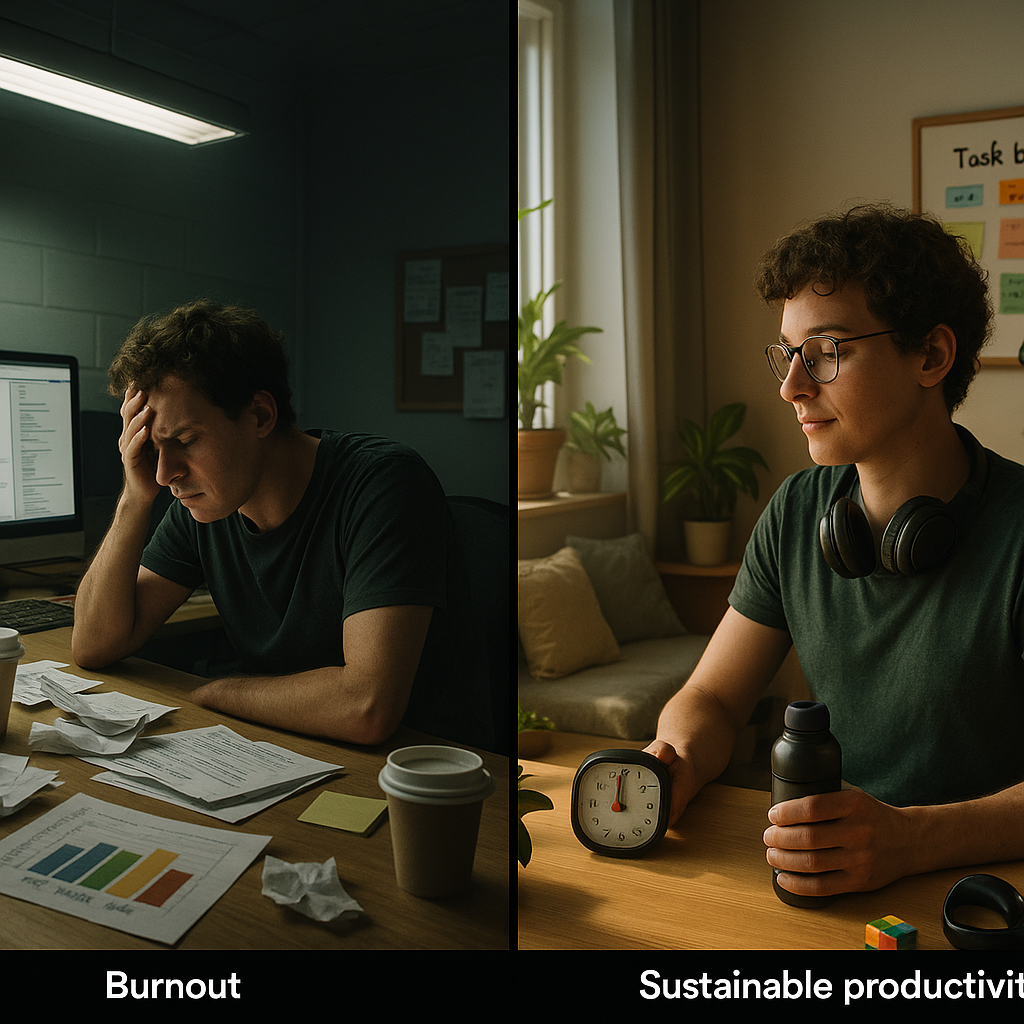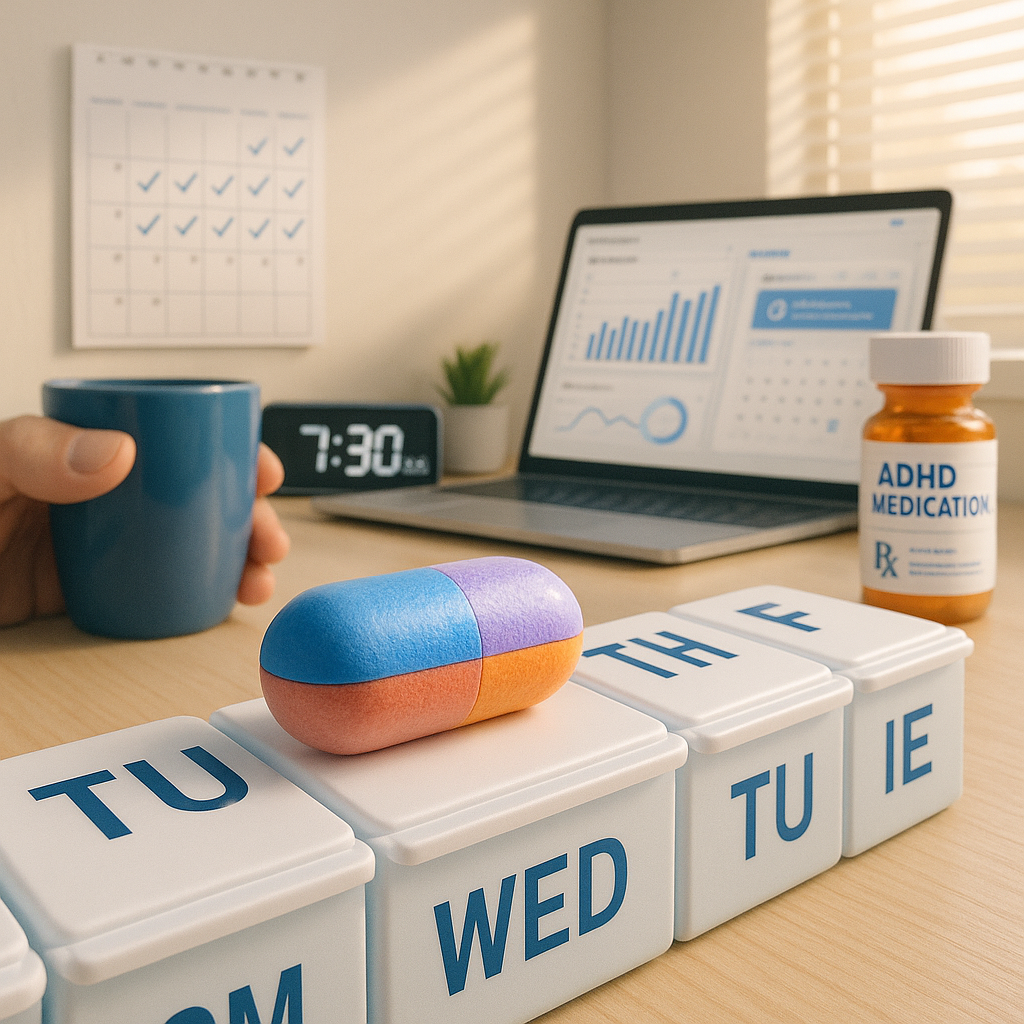Key Takeaways
- Redefine rest as productive, not a failure: View downtime as a necessary fuel for sustained energy and focus, especially for ADHD minds. Rest is not a sign of laziness or lack of effort, but a critical element for long-term performance and well-being.
- Challenge the productivity myth: Recognize and reject the belief that nonstop hustle is the measure of personal worth. Questioning this toxic narrative is essential for breaking cycles of neurodivergent burnout and building a healthier relationship with work.
- Spot hidden burnout before it escalates: ADHD burnout can appear as emotional exhaustion, decreased motivation, or even physical symptoms like headaches and increased sensitivity. Early awareness allows timely intervention before reaching the breaking point.
- Embrace pacing systems tailored to your brain: Implementing structured breaks, micro-rewards, and flexible routines helps regulate energy and manage overwhelm. There is no one-size-fits-all approach; personalization is key.
- Make self-compassion your burnout backup plan: Feeling guilty for resting only deepens exhaustion. Treat yourself with understanding, just as you would support a friend. Self-kindness is the foundation of resilience and ongoing growth.
- Set boundaries as if your energy depends on it (because it does): Prioritizing buffer time, recovery periods, and the power of saying no shields you from burnout and allows you to consistently operate at your best.
- Swap burnout cycles for lasting stamina: By normalizing rest, listening to your body’s needs, and discarding outdated productivity dogmas, you create space for real growth and discover a sustainable version of success that works for you.
These principles form the starting point for a transformative mindset shift. Instead of treating rest as an afterthought, embrace it as a strategic ally that honors your neurodivergent makeup. The following sections explore how pacing, compassion, and a new definition of productivity can help you recover from ADHD burnout and build a thriving, sustainable future.
Introduction
Does it feel like you’re running at full speed only to find yourself stuck in the same place, if not even more worn down than before? For many individuals with ADHD, burnout isn’t simply about crashing at the end of a busy week. It is a recurring cycle driven by unrealistic expectations and persistent guilt over slowing down.
But what if the real secret to recovery lies in redefining what it means to be productive? Rest and intentional pacing are not the obstacles. Rather, they are the building blocks for genuine healing. By making rest an active part of your strategy, becoming attuned to early signs of ADHD burnout, and weaving compassion into your daily routine, you can transform persistent exhaustion into lasting stamina.
This article explores the power of self-compassion, adaptive pacing, and a mindset that fully appreciates the unique workings of your neurodivergent brain. Instead of letting burnout rule your days, discover how real recovery and sustainable success can become your new norm.
Understanding ADHD Burnout’s Unique Pattern
To move toward recovery, it is vital to recognize exactly how ADHD burnout differs from ordinary fatigue. This is not simply “being tired.” It is a neurological shutdown that disrupts executive function, turning even straightforward tasks into steep mountains.
Core Symptoms of ADHD-Specific Burnout:
- Heightened executive dysfunction that impedes organization and follow-through
- Amplified emotional swings or irritability
- Loss of interest—even in usually engaging activities or hobbies
- Physical symptoms like headaches, digestive issues, or heightened sensory sensitivity
- Deep-seated shame or embarrassment linked to the need for extra downtime
The distinctive burnout cycle for those with ADHD generally starts with periods of intense hyperfocus. During these phases, energy and attention are pushed to the edge, often at the expense of basic needs such as sleep and nutrition. Eventually, the crash comes. You’re left depleted and sometimes unable to complete the simplest daily tasks. This creates what is called the “ADHD Energy Debt Spiral”: borrowing energy from the future until the present moment feels unsustainable.
Recognizing this pattern matters because standard advice for overcoming burnout frequently falls short for neurodivergent minds. It is not just about taking it easy for a few days. Lasting recovery requires methods uniquely suited to how ADHD brains operate under prolonged pressure.
The Productivity Myth That Hurts Us
Our cultural obsession with productivity fuels the misconception that rest must be “earned.” This belief is especially damaging for those with ADHD because it denies the cyclical and often unpredictable ways our energy ebbs and flows. The “hustle culture” norm, rewarding constant output, sets up neurodivergent individuals for feelings of inadequacy and ongoing burnout.
Why Conventional Productivity Models Fall Short
Traditional productivity systems assume these three things:
- Energy can be spent at a steady, predictable rate.
- Output is consistent across time.
- Recovery needs happen on a fixed schedule.
However, for people with ADHD, energy levels behave more like a renewable but volatile resource. You might experience several hours of high drive and focus, only to confront abrupt, severe fatigue. Fitting this reality into a rigid productivity mold leaves many feeling like chronic underachievers.
This disconnect often triggers what can be called the “productivity guilt spiral.” You push yourself when depleted, ignore cues to rest, and measure your worth by neurotypical standards. The resulting shame and frustration further sap your motivation and resilience.
It’s important to remember that these patterns are not personal flaws but symptoms of a systemic misunderstanding of how neurodivergent minds function best.
Redefining Rest as Productive Action
The game-changing shift is to see rest as an integral part of sustained achievement, not as its opposite. For ADHD brains, productive periods are only possible because downtime allows for brain maintenance, neural recalibration, and emotional reset.
Strategies That Emphasize the Positive Power of Rest:
- Approach rest as neurological self-care, supporting long-term focus and stability.
- Acknowledge that downtime after exertion is essential, not optional.
- Embrace short breaks and “pause” moments as tools for preventing mistakes or frustration.
- Recognize that rest buffers you from recovery “debt” and helps expand your productive window over time.
Scientific Insights on Rest for ADHD
Modern research highlights several biological differences in ADHD brains:
- Higher energy demands during focused tasks lead to quicker depletion.
- More frequent dopamine resets are required to maintain motivation and attention.
- Recovery following intense mental work is longer and more essential.
- Proactive rest routines can measurably enhance overall performance, creativity, and emotional regulation.
By understanding the science behind your rest needs, you can trade self-judgment for a strategic approach to caring for your brain, paving the way for improved well-being and output.
Practical Pacing Strategies for ADHD Minds
Achieving sustainable energy usage requires structures that align with your natural rhythms rather than resisting them. This involves both planning ahead and adapting in real time based on your body’s signals.
Step 1: Map Your Energy Landscape
- Keep a simple log of your mood, concentration, and stamina across each day. Identify patterns, such as peak energy hours and periods of fatigue.
- Note which tasks deplete you and which restore you (everyone’s profile is unique).
- Measure recovery time after mentally demanding or emotionally charged activities.
Step 2: Build Adaptive Routines
- Replace strict schedules with templates based on energy, not the clock. Try organizing your to-do list by low- and high-energy requirements.
- Insert flexible “buffer zones” between appointments or big tasks to allow for decompression and transition.
- Make regular rest non-negotiable by scheduling it just as you would important meetings.
- Use reminders or permission slips to prompt breaks, especially when you tend to hyperfocus.
Step 3: Use Proven Implementation Tools
The “Energy Account” Approach:
Treat your daily energy like a bank account. Every task (even enjoyable ones) acts as a withdrawal; rest deposits energy back in. Prioritize keeping a healthy balance through pre-planned, guilt-free downtime and stop yourself before the account hits zero.
The “Focus Burst” Method:
Embrace your ability to concentrate deeply for short intervals. Work intensely during peak focus, then allow yourself a real break—even if quick. Try pairing focused bursts with body doubling, movement, or mini-rewards to reinforce positive momentum while nurturing recovery.
These personalized tools ensure you maintain forward progress without constantly risking another burnout cycle. The key is consistency, listening and responding to your body rather than pushing past its limits.
Building a Rest-Positive Environment
Your physical setting and the people around you play an enormous role in making rest feel valid and accessible. Cultivating a supportive environment amplifies your ability to honor downtime without guilt.
Physical Space for Restoration
- Designate specific zones for relaxation, quiet, or sensory decompression—even if just a favorite chair or corner with soft lighting.
- Minimize visual or auditory clutter in work areas to reduce sensory overload.
- Have fidget-friendly tools or comfort objects nearby to ease transitions between activity and rest.
- Arrange furniture and decor to encourage easy shifts from high-focus tasks to moments of recovery.
Social Boundaries That Support Energy Management
- Proactively educate family, friends, or colleagues about the realities of ADHD energy cycles. Open conversations increase empathy and reduce misunderstandings.
- Communicate when you need undisturbed breaks or why you might say no to extra commitments.
- Seek out allies or accountability partners who respect your rest needs and can reinforce your efforts.
- Practice assertiveness. Remember that prioritizing your mental health is not selfish—it is how you bring your best to both work and relationships.
A rest-positive environment is about more than just physical cues. It is a culture where it feels safe to step away, recharge, and return stronger, with no shame or second-guessing.
Expanding the Framework: Industry and Life Applications
The principle of pacing and rest as productivity multipliers extends far beyond individual well-being and can transform workplaces, education, and broader systems.
- Healthcare: Professionals managing high-stress caseloads (whether clinicians or support staff) benefit from scheduled micro-breaks to reduce errors and improve patient care. Patients with ADHD or other neurodivergences require flexible appointment structures to avoid overwhelm.
- Education: Teachers and students alike thrive when classrooms offer “reset time” to recharge. Incorporating movement breaks or quiet zones improves academic outcomes, especially for neurodivergent learners.
- Corporate and Creative Sectors: Companies that design workflows around natural attention cycles (rather than rigid hours) see improved engagement and innovation. Creative teams use pulses of work and renewal to foster originality and prevent group burnout.
- Legal and Financial Fields: High-pressure environments often foster chronic overwork. Encouraging pacing and normalizing regular leave can reduce costly mistakes and increase long-term performance.
- Entrepreneurship: Solopreneurs and founders, particularly those with ADHD traits, build more resilient businesses when they structure their schedules with non-negotiable rest and recovery windows.
By adopting these principles across sectors, organizations not only support individuals but create cultures where innovation and well-being go hand in hand.
Conclusion
Burnout for ADHD professionals and individuals is not a product of weakness or laziness. It is a predictable outcome when neurodivergent energy rhythms collide with societal expectations that don’t fit. By redefining rest as a strategic asset, mapping personal energy cycles, and constructing environments that honor recovery, we reject guilt- and shame-based productivity for systems that actually work.
Looking forward, the future belongs to those who not only adapt but proactively design their lives and workplaces around their unique operating systems. Sustainable success, both personal and professional, is found not in relentless output but in honoring the full cycle of effort and renewal. For every neurodivergent thinker, the real breakthrough comes from turning what was once considered a liability (your distinct energy pattern) into your greatest competitive advantage.
This is the beginning of brilliance. By embracing rest as a tool, not a failure, you unlock a new level of clarity, resilience, and achievement. Now is the time to lead the shift: build systems, set boundaries, and celebrate how your mind works best—not just for today, but for the future you deserve.





Leave a Reply